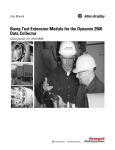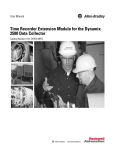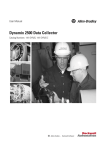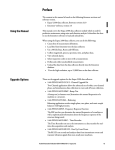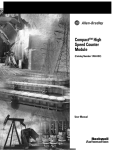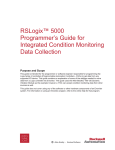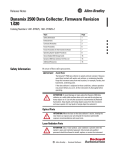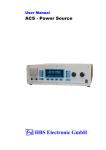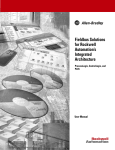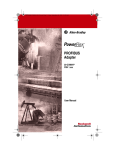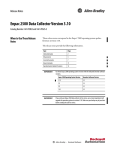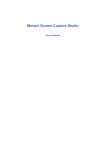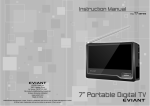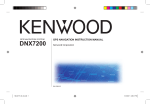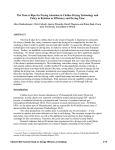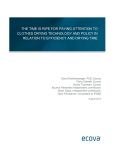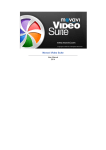Download 1441-UM006 - Rockwell Automation
Transcript
User Manual Run Up Coast Down Extension Module for the Dynamix 2500 Data Collector Catalog Number 1441-DYN25-MRUC Important User Information Solid-state equipment has operational characteristics differing from those of electromechanical equipment. Safety Guidelines for the Application, Installation and Maintenance of Solid State Controls (publication SGI-1.1 available from your local Rockwell Automation sales office or online at http://www.rockwellautomation.com/literature/) describes some important differences between solid-state equipment and hard-wired electromechanical devices. Because of this difference, and also because of the wide variety of uses for solid-state equipment, all persons responsible for applying this equipment must satisfy themselves that each intended application of this equipment is acceptable. In no event will Rockwell Automation, Inc. be responsible or liable for indirect or consequential damages resulting from the use or application of this equipment. The examples and diagrams in this manual are included solely for illustrative purposes. Because of the many variables and requirements associated with any particular installation, Rockwell Automation, Inc. cannot assume responsibility or liability for actual use based on the examples and diagrams. No patent liability is assumed by Rockwell Automation, Inc. with respect to use of information, circuits, equipment, or software described in this manual. Reproduction of the contents of this manual, in whole or in part, without written permission of Rockwell Automation, Inc., is prohibited. Throughout this manual, when necessary, we use notes to make you aware of safety considerations. WARNING: Identifies information about practices or circumstances that can cause an explosion in a hazardous environment, which may lead to personal injury or death, property damage, or economic loss. ATTENTION: Identifies information about practices or circumstances that can lead to personal injury or death, property damage, or economic loss. Attentions help you identify a hazard, avoid a hazard, and recognize the consequence SHOCK HAZARD: Labels may be on or inside the equipment, for example, a drive or motor, to alert people that dangerous voltage may be present. BURN HAZARD: Labels may be on or inside the equipment, for example, a drive or motor, to alert people that surfaces may reach dangerous temperatures. IMPORTANT Identifies information that is critical for successful application and understanding of the product. Allen-Bradley, Rockwell Software, Rockwell Automation, Emonitor, Dynamix, Enpac, and TechConnect are trademarks of Rockwell Automation, Inc. Trademarks not belonging to Rockwell Automation are property of their respective companies. Table of Contents Preface Optional Extension Modules. . . . . . . . . . . . . . . . . . . . . . . . . . . . . . . . . . . . . . . . 5 Additional Resources . . . . . . . . . . . . . . . . . . . . . . . . . . . . . . . . . . . . . . . . . . . . . . . 6 Chapter 1 Installing Optional Extension Modules Install an Extension Module . . . . . . . . . . . . . . . . . . . . . . . . . . . . . . . . . . . . . . . . 7 Uninstall Extension Modules. . . . . . . . . . . . . . . . . . . . . . . . . . . . . . . . . . . . . . . . 9 Manage Extension Modules . . . . . . . . . . . . . . . . . . . . . . . . . . . . . . . . . . . . . . . 12 Extension Module Battery Status Indicators . . . . . . . . . . . . . . . . . . . . . . . . 13 Chapter 2 Run Up/Coast Down Extension Module Set Up Run Up/Coast Down Measurements . . . . . . . . . . . . . . . . . . . . . . . Collect Run Up/Coast Down Measurements. . . . . . . . . . . . . . . . . . . . . . . Displaying Measurements by Using a Bode Plot. . . . . . . . . . . . . . . . . . . . . Set Up the Bode Plot . . . . . . . . . . . . . . . . . . . . . . . . . . . . . . . . . . . . . . . . . Display the Bode Plot . . . . . . . . . . . . . . . . . . . . . . . . . . . . . . . . . . . . . . . . . Displaying Measurements Using a Nyquist Plot. . . . . . . . . . . . . . . . . . . . . Set Up the Nyquist Plot. . . . . . . . . . . . . . . . . . . . . . . . . . . . . . . . . . . . . . . Display the Nyquist Plot . . . . . . . . . . . . . . . . . . . . . . . . . . . . . . . . . . . . . . Displaying Measurements in Table Format . . . . . . . . . . . . . . . . . . . . . . . . . Set Up the Table . . . . . . . . . . . . . . . . . . . . . . . . . . . . . . . . . . . . . . . . . . . . . Display the Table. . . . . . . . . . . . . . . . . . . . . . . . . . . . . . . . . . . . . . . . . . . . . Displaying Measurements Using a Waterfall. . . . . . . . . . . . . . . . . . . . . . . . Set Up the Waterfall . . . . . . . . . . . . . . . . . . . . . . . . . . . . . . . . . . . . . . . . . . Display the Waterfall Plot. . . . . . . . . . . . . . . . . . . . . . . . . . . . . . . . . . . . . Displaying Measurements Using a Spectrogram. . . . . . . . . . . . . . . . . . . . . Set Up the Spectrogram Plot . . . . . . . . . . . . . . . . . . . . . . . . . . . . . . . . . . Display the Spectrogram Plot . . . . . . . . . . . . . . . . . . . . . . . . . . . . . . . . . . Save Run Up/Coast Down Measurements . . . . . . . . . . . . . . . . . . . . . . . . . Recall a Setup . . . . . . . . . . . . . . . . . . . . . . . . . . . . . . . . . . . . . . . . . . . . . . . . . . . . Review Run Up/Coast Down Measurements . . . . . . . . . . . . . . . . . . . . . . . Screen Capturing . . . . . . . . . . . . . . . . . . . . . . . . . . . . . . . . . . . . . . . . . . . . . . . . Delete Run Up/Coast Down Files . . . . . . . . . . . . . . . . . . . . . . . . . . . . . . . . . 17 19 22 22 24 25 25 27 28 28 30 31 31 33 36 36 38 40 41 43 45 45 Index Rockwell Automation Publication 1441-UM006A-EN-P - May 2011 3 Table of Contents Notes: 4 Rockwell Automation Publication 1441-UM006A-EN-P - May 2011 Preface This manual covers the Dynamix 2500 data collector Run Up Coast Down (RUCD) extension module. When using the Dynamix 2500 Data Collector Run Up Coast Down Extension Module, you can do the following: • Record and analyze data from intermittent events and transient vibration signals from non-steady state machines. • Analyze a machine’s critical speeds and resonant frequencies. Optional Extension Modules These are the optional extension modules for the Dynamix 2500 data collector: • 1441-DYN25-4C, 4-channel Activation (1) The 4-channel activation lets you take 3- or 4- channel magnitude, time waveform, spectra, and Offroute measurements. • 1441-DYN25-MBMP Bump Test The Bump test (or hammer test) determines the natural frequencies of a machine or a structure. • 1441-DYN25-MBAL Balancing The Balancing test resolves single-plane, two-plane, and static-couple balances with high precision. • 1441-DYN25-MFRF Frequency Response Function The FRF test lets you determine the natural frequencies of a machine as well as sophisticated information about the frequency response of the structure being tested. • 1441-DYN25-MREC Time Recorder The Time Recorder test uses a the instrument as a data recorder for realtime data acquisition and analysis. • 1441-DYN25-MRUC Run Up Coast Down The RUCD test records and analyzes data from intermittent events and transient vibration signals from non-steady state machines. See Additional Resources on page 6 for a listing of available publications. (1) This is an activation license for the Dynamix 2500 data collector. Rockwell Automation Publication 1441-UM006A-EN-P - May 2011 5 Preface Additional Resources These documents contain additional information concerning products from Rockwell Automation. Resource Description Dynamix 2500 Data Collector User Manual, publication 1441-UM001 Describes the Dynamix 2500 data collector which provides predictive maintenance by using noise and vibration analysis. Dynamix 2500 Data Collector Bump Test Extension Module User Manual, publication 1441-UM002 Describes how determine natural (or resonant) frequencies of a machine or structure. Dynamix 2500 Data Collector Frequency Response Function Extension Module User Manual, publication 1441-UM003 Describes how to determine the natural frequencies of a machine or structure using modal hammer. Dynamix 2500 Data Collector Balancing Extension Module User Manual, publication 1441-UM004 Describes the direct method to balance your rotating machinery in one or two planes. Dynamix 2500 Data Collector Time Recorder Extension Module User Manual, publication 1441-UM005 Describes how to use the data collector as a data recorder for real-time data acquisition, post processing, and analysis. Emonitor User’s Guide, publication EMONTR-UM001 Describes data management for predictive maintenance services. Dynamix 2500 Data Collector Kit Release Notes, publication 1441-RN001 Provides important information on the latest updates, for example, firmware, certifications, warnings, and hardware changes for the data collector. Dynamix 2500 Data Collector Optional Extension Modules Release Notes, publication 1441-RN002 Provides important information on how to install the Optional Extension Modules onto the Dynamix 2500 data collector. Industrial Automation Wiring and Grounding Guidelines, publication 1770-4.1 Provides general guidelines for installing a Rockwell Automation industrial system. Product Certifications website, http://www.ab.com Provides declarations of conformity, certificates, and other certification details. You can view or download publications at http://www.rockwellautomation.com/ literature. To order paper copies of technical documentation, contact your local Allen-Bradley distributor or Rockwell Automation sales representative. 6 Rockwell Automation Publication 1441-UM006A-EN-P - May 2011 Chapter 1 Installing Optional Extension Modules The data collector uses the Extension Manager to install and uninstall extension modules. These extension modules are licensed and ordered separately from the basic entry level product. Topic Page Install an Extension Module 7 Uninstall Extension Modules 9 Manage Extension Modules 12 Extension Module Battery Status Indicators 13 The installation Secure Digital (SD) cards that you receive work with any Dynamix 2500 data collector. Once you have installed an extension module, the card is locked so that it can be used only with that instrument. IMPORTANT One installation SD card is required for each instrument that needs to be upgraded. You can uninstall extension modules if required. When uninstalling an extension module, you have the option to free up the license so you can install the extension module on another instrument. This makes the extension module available to be transferred between units. IMPORTANT When ever you re-run the OS Loader software, you will re-load only the main OS firmware. The OS loader will backup licence files and data, but not the optional extension modules. Once you have updated the OS firmware, install the latest version of your optional extension modules. See the Dynamix 2500 Data Collector User Manual, 1441-UM001, for more information. Install an Extension Module Follow these instructions to install an extension module. 1. Open the base cover at the bottom of the Dynamix 2500 data collector. 2. Place the extension module SD card contact side-up into the unit until it is firmly seated in place. 3. Close the base cover. Rockwell Automation Publication 1441-UM006A-EN-P - May 2011 7 Chapter 1 Installing Optional Extension Modules 4. Apply power to the data collector. 5. From the Main Menu, select Setup Utility and press Enter. 6. Press 0 (Shift) to display the second set of functions. Extension Manager The Extension Manager function remains on the screen for about 3 seconds after releasing 0 (Shift). 7. Press F1 (Extn Mgr). The Extension Manager screen appears showing the current extension module installations. 8. Press 0 (Shift) to display the Install extension function. 9. Press F2 (Install) to install the new extension module. 8 Rockwell Automation Publication 1441-UM006A-EN-P - May 2011 Installing Optional Extension Modules Chapter 1 When the installation is complete, a confirmation prompt appears. 10. Press F4 (OK). The new extension module appears in the list. 11. Press F4 (Esc) to exit the Extension Manager screen. Uninstall Extension Modules Follow these instructions to uninstall an extension module. 1. Press 0 (Shift) from the Setup Utility screen to display the Extension Manager function. The Extension Manager function remains on the screen for about three seconds after releasing 0 (Shift). Extension Manager 2. Press F1 (Extn Mgr). Rockwell Automation Publication 1441-UM006A-EN-P - May 2011 9 Chapter 1 Installing Optional Extension Modules The Extension Manager screen appears. This screen lists the extension modules currently installed and the on the unit. 3. Select the extension module you want to uninstall and press F3 (Select). F3 (Select) toggles the selection on and off. 10 Rockwell Automation Publication 1441-UM006A-EN-P - May 2011 Installing Optional Extension Modules Chapter 1 A checkmark appears next to that extension module. 4. Press F1 (Uninstall). A confirmation message appears. 5. Make sure your installation card is inserted into the instrument. IMPORTANT The extension module is uninstalled and the license on the card is released so that the card can be used to install the extension module on another Dynamix 2500 data collector. If the installation card is not inserted in the instrument and no card, you are is found or the card does not have the extension module license for the unit, you are prompted to insert the correct installation card or continue without freeing the license. 6. Press F2 (Yes) to uninstall the extension module. 7. Press F4 (Esc) to exit the Extension Manager screen. Rockwell Automation Publication 1441-UM006A-EN-P - May 2011 11 Chapter 1 Installing Optional Extension Modules Manage Extension Modules The Dynamix 2500 data collector lets you to hide installed extension modules from the Main Menu. You may need to hide an advanced extension module icon from an inexperienced user, for example, RUCD and FRF. IMPORTANT Once an extension module is hidden, its icon is not represented on the Main Menu or displayed in the Dynamix 2500 data collector About screen. Follow these instructions to hide or show an extension module icon on the Main Menu. 1. Press 0 (Shift) on the Setup Utility screen to display the Extension Manager function. The Extension Manager function should remain on the screen for approximately three seconds after releasing 0 (Shift). 2. Press F1 (Extn Mgr). The Extension Manager screen appears. The Extension Manager displays a list of installed extensions module. The extension modules that are hidden are shown in [square brackets]. The F2 (Hide) toggles between Hide and Show depending if the selected extension module is hidden or not. TIP 12 You have to exit and re-enter the Extension Manager after hiding an extension module to have the Show function appear. Rockwell Automation Publication 1441-UM006A-EN-P - May 2011 Installing Optional Extension Modules Chapter 1 3. Select the extension module that you want to hide or show and press F2 (Show/Hide). TIP If you want to show or hide multiple extension modules simultaneously, select each extension module and press F3 (Select). A checkbox appears next to each selected extension module. If you select multiple extension modules and some are hidden while others are shown, F2 (Show/Hide) reflects the status of the selected extension module. 4. Press F4 (Esc) to exit the Extension Manager. Extension Module Battery Status Indicators The battery status icons show the strength of the battery. Table 1 - Extension Module Battery Icon Descriptions Battery Icon Meaning Battery status is good: >30% life remaining. Battery status is low: >10% life remaining. Battery status is very low: <10% life remaining. Battery is charging. Rockwell Automation Publication 1441-UM006A-EN-P - May 2011 13 Chapter 1 Installing Optional Extension Modules Notes: 14 Rockwell Automation Publication 1441-UM006A-EN-P - May 2011 Chapter 2 Run Up/Coast Down Extension Module The Run Up/Coast Down (RUCD) extension module is an optional module for the Dynamix 2500 data collector. You install the extension module with the RUCD Secure Digital (SD) card. See Installing Optional Extension Modules on page 7 for installation instructions. Topic Page Set Up Run Up/Coast Down Measurements 17 Collect Run Up/Coast Down Measurements 19 Displaying Measurements by Using a Bode Plot 22 Displaying Measurements Using a Nyquist Plot 25 Displaying Measurements in Table Format 28 Displaying Measurements Using a Waterfall 31 Displaying Measurements Using a Spectrogram 36 Save Run Up/Coast Down Measurements 40 Recall a Setup 41 Review Run Up/Coast Down Measurements 43 Screen Capturing 45 Delete Run Up/Coast Down Files 45 The Run Up/Coast Down extension module lets the data collector record and analyze data from intermittent events and transient vibration signals from non-steady state machines. The Run Up/Coast Down extension module is used to record and analyze data from machines where noise or vibration levels are changing with speed or time such as during a run up (increase in speed), coast down (decrease in speed), or other applications causing transient phenomena. You use the data to analyze a machine’s critical speeds and resonant frequencies. Rockwell Automation Publication 1441-UM006A-EN-P - May 2011 15 Chapter 2 Run Up/Coast Down Extension Module The application acquires a simultaneous noise or vibration signal and a tachometer signal. This example setup includes the following: • Accelerometer attached to connector A of the Dynamix 2500 data collector • Optical tachometer signal connected to the POWER/USB/TRIGGER cable • Tripod for tachometer signal stability • Speed reference trigger • Small piece of reflective tape on the part of the shaft can serve as a reference trigger or you can simply pass the laser over a notch in the shaft This graphic illustrates a typical Run Up/Coast Down setup. Figure 1 - Run Up/Coast Down Setup Accelerometer Reflective Tape Tachometer Tripod 32147-M The recorded data is saved in the form of a Microsoft .wav time waveform file. You can analyze this file and viewed in a variety of different formats including: • • • • • 16 Bode Plot Nyquist Plot Table Waterfall Spectrogram Rockwell Automation Publication 1441-UM006A-EN-P - May 2011 Run Up/Coast Down Extension Module Set Up Run Up/Coast Down Measurements Chapter 2 The first step in the Run Up/Coast Down extension module is to setup how the measurements are taken by the data collector. 1. Select RUCD on the Main Menu and press the Enter. The RUCD screen appears. 2. Select Setup and press Enter to set up the Run Up/Coast Down parameters. The RUCD - Setup screen appears. 3. Select a parameter and press the Right arrow to open a list of values. 4. Select or type the parameter value. 5. Press Left arrow to save your selection. 6. Press F2 (Save) to save the current settings to a file. See Save Run Up/Coast Down Measurements on page 40 for details. Rockwell Automation Publication 1441-UM006A-EN-P - May 2011 17 Chapter 2 Run Up/Coast Down Extension Module Use these descriptions to help you configure the parameters in the Run Up/Coast Down Setup screen. Table 2 - Run Up/Coast Down Setup Parameters Parameter Description Values/Comments Transducer Specifies the type of sensor used on Connector A, this is typically Accel (g). Accel ICP (g) (default) The specified sensor type determines available options and engineering units for subsequent setup fields. Accel ICP (m/s2) Accel (g) Accel (m/s2) Vel ICP (mm/s) Vel (mm/s) Vel ICP (ips) Vel (ips) Disp (mils) Disp (µm) Volts AC User (EU) Sens (mV/EU) Range (EU) The transducer sensitivity in millivolts (MV) per engineering units (EU). 1…2000 (mV/EU) The expected maximum amplitude range value for the incoming input signal. .1 EU The range should accommodate for unexpected events. If you are unsure about the range value, set the range 10 to 20 times higher than expected. .5 EU 100 (default) .2 EU 1 EU 2 EU (default) 5 EU 10 EU 20 EU (default) 50 EU 100 EU 200 EU 500 EU 1000 EU 2000 EU Max M/c Speed Max No Orders Mode The maximum speed that the shaft will reach in rpm. 10…60000 rpm This is used with Max No Orders to determine the sampling rate. 3600 rpm (default) The maximum number of shaft orders of interest during analysis. 1 to 166 This is used with Max M/c Speed to determine the sampling rate. 32 (default) The method for initiating the data collection. Runup (default) • Runup - The data collection starts when the machine speed rises above Start Spd. • Coast down -The data collection starts when the machine speed falls below Stop Spd. • Manual - Manually start data collection by pressing F4 (Start). No tachometer signal is required for this mode. 18 Rockwell Automation Publication 1441-UM006A-EN-P - May 2011 Manual Coastdown Run Up/Coast Down Extension Module Chapter 2 Table 2 - Run Up/Coast Down Setup Parameters Parameter Description Values/Comments Pulses/Rev The number of tachometer signal pulses per revolution of the reference shaft. .1…1000 To acquire a suitable tachometer signal, the tachometer signal must be approximately 1.5 volts peak-to-peak. The adverse effect of excessively short tachometer pulse widths can be addressed by setting the Max No Order to a higher value to increase the sampling rate. This number can be a multiple or a noninteger to accommodate, for example, gear ratios. Sets the speed at which the unit should start collecting data. 10…3600 rpm Start Spd (RPM) • If Mode is set to Runup, this value must be less than the Stop Spd. • If Mode is set to Coast down, this value must be greater than the Stop Spd. 1 (default) 60 rpm (default) This parameter is not available if Mode is set to Manual. Stop Spd (RPM) Sets the speed at which the unit should stop collecting data. • If Mode is set to Runup, this value must be greater than the Start Spd. • If Mode is set to Coast down, this value must be less than Start Spd. 10…3600 rpm 300 rpm (default) This parameter is not available if Mode is set to Manual. Save To Max Acq Time (s) Sets the location where data is saved. Internal (default) Save the data to the SD or PC card if the .wav files will be large. Your selection affects the maximum recording time. SD Card The number of seconds to record the time waveform. 1…1131.65 s This limit applies only if the run up or coast down takes longer than the time set here. 1131.65 s (default) Collect Run Up/Coast Down Measurements This section describes the Run Up/Coast Down status indicators and how to collect Run Up/Coast Down data. Table 3 - RUCD Status Indicators Indicator Status Description Red Solid An overload error (clipping or streaming error) has occurred during data collection. Amber Solid An error has occurred during data collection The status indicator turns off when the error condition disappears. Green Flashing Green No errors occurred during data collection. Once you have configured the parameters, you can begin collecting data. The data is automatically recorded as a .wav file, which can then be analyzed using several different types of plots. 1. Using the a tachometer cable, connect the reference input device to the POWER/USB/TRIGGER connector and the transducer to connector A. 2. Align the reference input device (tachometer, optical tachometer, or strobescope) to capture shaft speed. Rockwell Automation Publication 1441-UM006A-EN-P - May 2011 19 Chapter 2 Run Up/Coast Down Extension Module 3. Attach a transducer to the bearing house. 4. Start the machine or stop the machine as needed. 5. From the RUDC Setup screen press F3 (Start). The RUCD - Taking Data screen appears. Current Speed of Machine Current Overall Vibration Reading Maximum Acquisition Time in the Armed State Remaining Recording Time in the Acquiring State Message Area The Dynamix 2500 data collector begins collecting run up or coast down data based on the parameters you selected. The state of the machine is indicated on the screen. State Description Armed The machine speed has not reached the Start Spd and data collection has not yet started. At any time during this state, you can press F3 (Start) to manually start data collection. Acquiring The machine speed has reached the Start Spd and data collection has started. At any time during this state, you can press F3 (Stop) to manually stop data collection. Error-Clipped An error occurred during data collection. If a sensor’s Range setting is too small to accommodate the signal’s amplitude, a message displays in the message error. Press F4 (Back) to return to the RUCD - Setup screen and increase the Range setting. Data collection is complete when the specified Stp Speed or Maximum Acquisition Time is reached, or you press F3 (Stop). 20 Rockwell Automation Publication 1441-UM006A-EN-P - May 2011 Run Up/Coast Down Extension Module Chapter 2 The resulting time waveform is recorded as a Microsoft Windows .wav file and the Acquisition Completed dialog appears on the screen. TIP If an error occurs during data collection, a message appears in this dialog box. 6. Press F4 (OK) to continue. The RUCD - Display Select screen appears. The Dynamix 2500 data collector provides five different formats for you to use to view the newly recorded time waveform. 7. Select the format and press F3 (Display). Format Description Bode Displays the magnitude and phase over a varying rpm. See Displaying Measurements by Using a Bode Plot on page 22. Nyquist Displays the selected orders as complex data. See Displaying Measurements Using a Nyquist Plot on page 25. Rockwell Automation Publication 1441-UM006A-EN-P - May 2011 21 Chapter 2 Run Up/Coast Down Extension Module Format Description Table Displays the magnitude and phase of selected orders at the varied rpm speeds in a table format. See Displaying Measurements in Table Format on page 28. Waterfall Displays multiple FFT traces overlaid and offset on one single plot. See Displaying Measurements Using a Waterfall on page 31. Spectrogram Displays multiple FFT traces on one single plot, using color to indicate relative magnitude. See Displaying Measurements Using a Spectrogram on page 36. 8. When you are finished analyzing the time waveform, you can save it to a file. See Save Run Up/Coast Down Measurements on page 40. Displaying Measurements by Using a Bode Plot The Bode plot is actually two graphs of 1X rpm amplitude and phase as a function of frequency. The screen shows both plots at the same time. The top plot shows magnitude versus rpm. The bottom plot shows phase versus rpm. Set Up the Bode Plot 1. Select Bode on the RUCD - Display Select screen and press F3 (Display). The RUCD - Bode Setup screen appears. 2. Select the parameter and press the Right arrow to open a list of values. 3. Select or type in the parameter value. 4. Press the Left arrow to save your selection. See Bode Plot Parameters on page 23 to help you configure the parameters. 22 Rockwell Automation Publication 1441-UM006A-EN-P - May 2011 Run Up/Coast Down Extension Module Chapter 2 5. When you are finished, press F3 (Display) to display the Bode plot. See Display the Bode Plot on page 24. Table 4 - Bode Plot Parameters Parameter Description Values/Comments Start Spd (RPM) Sets the start speed of the recorded data for the Bode plot. 10…3600 rpm This defaults to the Start Spd value set in the RUCD Setup screen. See Table 2 on page 18. Stop Spd (RPM) Sets the stop speed of the recorded data for the Bode plot. 10…3600 rpm This defaults to the Stop Spd value set in the RUCD Setup screen. See Run Up/Coast Down Setup Parameters on page 18. Spacing Controls the spacing between collected spectra. • Δ rpm is a fixed speed change between spectra. • % Δ rpm is a percentage speed change between spectra. • Δ Time is a fixed time interval between spectra. • Δ rpm + Δ Time is a combination of speed and time interval settings. If speed stops changing then spectra are calculated using the Time Interval value. • % Δ rpm + Δ Time is a combination of speed and time interval settings. If speed stops changing then spectra are calculated using the Time Interval value. Speed Interval (rpm) Sets the speed interval used in calculating FFT spectra. Δ rpm % Δ rpm Δ Time Δ rpm + Δ Time % Δ rpm + Δ Time Your selection affects the Speed Interval and Time Interval settings. 1…240 rpm or % rpm This parameter not used when Spacing is set to Δ Time. Time Interval (sec) Sets the time interval used in calculating FFT spectra. Enter a value from .001…604800 s This parameter is not used when Spacing is set to Δ rpm and % Δ rpm. Display Units Sets the Y-axis units. Accel (g) The available units depends on the transducer used to collect data. Accel (m/s2) See Run Up/Coast Down Setup Parameters on page 18. Accel (m/s2) Vel (mm/s) Vel (ips) Disp (mils) Disp (µm) LF Cutoff Detection Determines whether to apply a low frequency filter (0.3 times the running speed) to the data. Off (default) Sets the signal detection and scaling display for the Bode plot: RMS On • Peak - Measured RMS value multiplied by the square root of two (1.4142). Peak (default) • Pk-Pk - Measured RMS value multiplied by two times the square root of PkPk two (2.8284). • RMS - Root mean squared signal level of the input signal. Y-axis Sets the y-axis scaling on the Bode plot: • Linear - The plot grid centers are linearly spaced in Y between the centers of the first and last grid. • Log - The plot grid centers are logarithmically spaced in Y between the centers of the first and last grid. Rockwell Automation Publication 1441-UM006A-EN-P - May 2011 Linear (default) Log 23 Chapter 2 Run Up/Coast Down Extension Module Table 4 - Bode Plot Parameters Parameter Description Values/Comments Show Overall Determines whether to display the overall severity as a trace on the Bode plot. Yes (default) No Num Traces Sets the number of traces or order tracks to be displayed on the Bode plot: • The number of traces available is determined by the Show Overall parameter. • Your selection determines the available number of Trace Order parameters. Trace Order #1…4 The order numbers to be tracked and displayed on the Bode plot. This value cannot exceed the Max No Orders value set in the RUCD Setup screen. 1 (default) 2 3 4 .001…166 orders See Run Up/Coast Down Setup Parameters on page 18. Display the Bode Plot When you are done setting up the Bode plot parameters, you can process the data and display the Bode plot by pressing F3 (Display) on the RUCD - Bode Setup screen. TIP The larger the .wav file, the longer it takes to process the data and display the plot. Active Trace Speed, Magnitude, and Q Factor at Cursor Location The top of the display shows magnitude versus rpm. The bottom of the display shows phase versus rpm: • To sequence through the traces, press the Up and Down arrows. The order number of the current trace is displayed in the top left corner of the screen. To move the cursor along the trace, press the Left and Right arrows. 24 Rockwell Automation Publication 1441-UM006A-EN-P - May 2011 Run Up/Coast Down Extension Module Chapter 2 • From the Bode plot you can also display the data in a Table format or Nyquist plot. To display the data in a table, press 0 (Shift) and F4 (Table). See Display the Table on page 30 for more information. • To display the data in a Nyquist plot, press 0 (Shift) and F1 (Nyqst). See Display the Nyquist Plot on page 27 for more information. Displaying Measurements Using a Nyquist Plot The Nyquist plot is a polar representation of the amplitude and phase angle as a function of frequency. Three variables are combined into a single plot in polar format. Set Up the Nyquist Plot 1. Select Nyquist on the RUCD - Display Select screen and press F3 (Display). The RUCD - Nyquist Setup screen appears. 2. Select the option and press the Right arrow to open a list of values. 3. Select or type in a parameter value. 4. Press the Left arrow to save your selection. Use the descriptions in Nyquist Plot Parameters on page 26 to help you configure the parameters. 5. When you are finished, press F3 (Display) to display the Nyquist plot. Rockwell Automation Publication 1441-UM006A-EN-P - May 2011 25 Chapter 2 Run Up/Coast Down Extension Module See Display the Nyquist Plot on page 27. Table 5 - Nyquist Plot Parameters Parameter Name Description Values/Comments Start Spd (RPM) Sets the start speed of the recorded data for the plot. 10…3600 rpm This defaults to the Start Spd value set in the RUCD Setup screen. See Run Up/Coast Down Setup Parameters on page 18. Stop Spd (RPM) Sets the stop speed of the recorded data for the plot. 10…3600 rpm This defaults to the Stop Spd value set in the RUCD Setup screen. See Run Up/Coast Down Setup Parameters on page 18. Spacing Controls the spacing between collected spectra: • Δ rpm is a fixed speed change between spectra. • % Δ rpm is a percentage speed change between spectra. • Δ Time is a fixed time interval between spectra. • Δ rpm + Δ Time is a combination of speed and time interval settings. If speed stops changing then spectra are calculated using the Time Interval value. • % Δ rpm + Δ Time is a combination of speed and time interval settings. If speed stops changing then spectra are calculated using the Time Interval value. Speed Interval (RPM) Sets the speed interval used in calculating FFT spectra. Δ rpm % Δ rpm Δ Time Δ rpm + Δ Time % Δ rpm + Δ Time Your selection affects the Speed Interval and Time Interval settings. 1… 240 rpm or % rpm This parameter not used when Spacing is set to Δ Time. Time Interval (sec) Sets the time interval used in calculating FFT spectra. .001…604800 s This parameter is not used when Spacing is set to Δ RPM and % Δ RPM. Display Units Sets the Y-axis units. The available units depends on the transducer used to collect data. See Run Up/Coast Down Setup Parameters on page 18. LF Cutoff Detection Determines whether to apply a low frequency filter (0.3 times the running speed) to the data. Off Sets the signal detection and scaling display for the plot: RMS • Peak - Measured RMS value multiplied by the square root of two (1.4142). • Pk-Pk - Measured RMS value multiplied by two times the square root of two (2.8284). • RMS - Root mean squared signal level of the input signal. Num Traces On Peak PkPk Sets the number of traces or order tracks to be displayed on the plot. 1 Your selection determines the available number of Trace Order parameters. 2 3 4 Trace Order #1-#4 The order numbers to be tracked and displayed on the plot. This value cannot exceed the Max No Orders value set in the RUCD Setup screen. See Run Up/Coast Down Setup Parameters on page 18. 26 Rockwell Automation Publication 1441-UM006A-EN-P - May 2011 .001…166 orders Run Up/Coast Down Extension Module Chapter 2 Display the Nyquist Plot When you are done setting up the plot parameters, you can process the data and display the Nyquist plot by pressing F3 (Display) on the RUCD - Nyquist Setup screen. TIP The larger the .wav file, the longer it takes to process the data and display the plot. Active Trace Speed, magnitude, and Q Factor at Cursor Location The display shows the selected orders as complex data with zero degrees along the positive X-axis and 90 degrees along the positive Y-axis: • To sequence through the traces, press the Up and Down arrows. The order number of the current trace is displayed in the top left corner of the screen. To move the cursor along the trace, press the Left and Right arrows. • From the Nyquist plot you can display the data in a table or Bode plot, press 0 (Shift) and F4 (Table). See Display the Table on page 30 for more information. • To display the data in a Bode plot, press 0 (Shift) and then F1 (Bode). See Display the Bode Plot on page 24 for more information. Rockwell Automation Publication 1441-UM006A-EN-P - May 2011 27 Chapter 2 Run Up/Coast Down Extension Module Displaying Measurements in Table Format The magnitude and phase of selected orders at the varied rpm speeds are displayed in a table. Set Up the Table 1. Select Table on the RUCD - Display Select screen and press F3 (Display). The RUCD - Table Setup screen appears. 2. Select a parameter press the Right arrow to open a list of values. 3. Select or type in a parameter value. 4. Press the Left arrow to save your selection. Use the descriptions in Table Parameter Descriptions on page 28 to help you configure the parameters. 5. When you are finished, press F4 (Display) to display the table. See Display the Table on page 30. Table 6 - Table Parameter Descriptions Parameter Name Description Values/Comments Start Spd (RPM) Sets the start speed of the recorded data for the table. 10…3600 rpm This defaults to the Start Spd value set in the RUCD Setup screen. See Run Up/Coast Down Setup Parameters on page 18. Stop Spd (RPM) Sets the stop speed of the recorded data for the table. This defaults to the Stop Spd value set in the RUCD Setup screen. See Run Up/Coast Down Setup Parameters on page 18. 28 Rockwell Automation Publication 1441-UM006A-EN-P - May 2011 10…3600 rpm Run Up/Coast Down Extension Module Chapter 2 Table 6 - Table Parameter Descriptions Parameter Name Description Values/Comments Spacing Controls the spacing between collected spectra: Δ rpm % Δ rpm Δ Time Δ rpm + Δ Time % Δ rpm + Δ Time • Δ rpm is a fixed speed change between spectra. • % Δ rpm is a percentage speed change between spectra. • Δ Time is a fixed time interval between spectra. • Δ rpm + Δ Time is a combination of speed and time interval settings. If speed stops changing then spectra are calculated using the Time Interval value. • % Δ rpm + Δ Time is a combination of speed and time interval settings. If speed stops changing then spectra are calculated using the Time Interval value. Speed Interval (RPM) Sets the speed interval used in calculating FFT spectra. Your selection affects the Speed Interval and Time Interval settings. 1…240 rpm or % rpm This parameter not used when Spacing is set to Δ Time. Time Interval (sec) Sets the time interval used in calculating FFT spectra. .001…604800 s This parameter is not used when Spacing is set to Δ RPM and % Δ RPM. Display Units Sets the Y-axis units. The available units depends on the transducer used to collect data. See Run Up/Coast Down Setup Parameters on page 18. LF Cutoff Detection Determines whether to apply a low frequency filter (0.3 times the running speed) to the data. Off Sets the signal detection and scaling display for the table: RMS • Peak - Measured RMS value multiplied by the square root of two (1.4142). • Pk-Pk - Measured RMS value multiplied by two times the square root of two (2.8284). • RMS - Root mean squared signal level of the input signal. Num Traces Trace Order #1-#4 On Peak PkPk Sets the number of traces or order tracks to be displayed in the table. 1 Your selection determines the available number of Trace Order parameters. 2 The order numbers to be tracked and displayed in the table. .001…166 orders This value cannot exceed the Max No Orders value set in the RUCD Setup screen. See Run Up/Coast Down Setup Parameters on page 18. Rockwell Automation Publication 1441-UM006A-EN-P - May 2011 29 Chapter 2 Run Up/Coast Down Extension Module Display the Table When you are done setting up the table parameters, you can process the data and display the table by pressing F4 (Display) on the RUCD - Table Setup screen. Up to two orders of the magnitude and phase data set is displayed in the table: • To scroll through the table, press the Up and Down arrows. • You can also display the data in a Bode plot. To display the data in a Bode plot or Nyquist plot, press 0 (Shift) and F4 (Bode). See Display the Bode Plot on page 24. • To display the data in a Nyquist plot, press 0 (Shift) and F1 (Nyquist). See Display the Nyquist Plot on page 27. 30 Rockwell Automation Publication 1441-UM006A-EN-P - May 2011 Run Up/Coast Down Extension Module Displaying Measurements Using a Waterfall Chapter 2 The Waterfall plot displays the vibration level in relation to the frequencies at which the vibration occurs. It lets you view several measurements in relationship to each other. Set Up the Waterfall 1. Select Waterfall on the RUCD - Display Select screen and press F3 (Display). The RUCD - Waterfall Setup screen appears. 2. Select the option and press the Right arrow to open a list of values. 3. Select or type in the parameter value. 4. Press the Left arrow to save your selection. Use the descriptions in Waterfall Plot Parameters on page 31 to help you configure the parameters. 5. When you are finished, press F3 (Display) to display the Waterfall plot. See Display the Waterfall Plot on page 33. Table 7 - Waterfall Plot Parameters Parameter Name Description Values/Comments Start Spd (RPM) Sets the start speed of the recorded data for the plot. 10…3600 rpm This defaults to the Start Spd value set in the RUCD Setup screen. See Run Up/Coast Down Setup Parameters on page 18. Stop Spd (RPM) Sets the stop speed of the recorded data for the plot. 10…3600 rpm This defaults to the Stop Spd value set in the RUCD Setup screen. See Run Up/Coast Down Setup Parameters on page 18. Rockwell Automation Publication 1441-UM006A-EN-P - May 2011 31 Chapter 2 Run Up/Coast Down Extension Module Table 7 - Waterfall Plot Parameters Parameter Name Description Values/Comments Spacing Controls the spacing between collected spectra: Δ rpm % Δ rpm Δ Time Δ rpm + Δ Time % Δ rpm + Δ Time • Δ rpm is a fixed speed change between spectra. • % Δ rpm is a percentage speed change between spectra. • Δ Time is a fixed time interval between spectra. • Δ rpm + Δ Time is a combination of speed and time interval settings. If speed stops changing then spectra are calculated using the Time Interval value. • % Δ rpm + Δ Time is a combination of speed and time interval settings. If speed stops changing then spectra are calculated using the Time Interval value. Speed Interval (RPM) Sets the speed interval used in calculating FFT spectra. Your selection affects the Speed Interval and Time Interval settings. 1…240 rpm This parameter not used when Spacing is set to Δ Time. Time Interval (sec) Sets the time interval used in calculating FFT spectra. .001…604800 s This parameter is not used when Spacing is set to Δ RPM and % Δ RPM. Display Units Sets the Y-axis units. The available units depends on the transducer used to collect data. See Run Up/Coast Down Setup Parameters on page 18. Detection Sets the signal detection and scaling display for the plot: RMS • Peak - Measured RMS value multiplied by the square root of two (1.4142). Peak • Pk-Pk - Measured RMS value multiplied by two times the square root of PkPk two (2.8284). • RMS - Root mean squared signal level of the input signal. Lines The number of lines (bins) of resolution for the FFT spectra. The larger the number of lines, the better the frequency resolution of the measured data in the spectra. Similarly, the higher the number of lines, the longer it takes to display the spectra in the plot. 100 200 400 800 1600 3200 6400 12800 X-axis Sets the x-axis frequency units for displaying spectra/FFT data: • Hz - Displays spectra in Hertz, cycles per second. • CPM - Displays spectra in cycles per minute. • Orders - Displays spectra in orders of the operating speed. Hz CPM Orders Your selection affects the Freq Range and LF Cutoff parameters. Freq. Range (EU) The maximum frequency for the measurement. 10…2000 Hz The frequency range is determined by the X-axis parameter. 600…120000 CPM .001…166 Orders 32 Rockwell Automation Publication 1441-UM006A-EN-P - May 2011 Run Up/Coast Down Extension Module Chapter 2 Table 7 - Waterfall Plot Parameters Parameter Name Description Values/Comments LF Cutoff (EU) Sets a low frequency cutoff filter to remove noise from the analysis. Off The available options are determined by the X-axis selection. 21.6 CPM 66 CPM 120 CPM 600 CPM 4200 CPM .36 Hz 1.1 Hz 2 Hz 10 Hz 70 Hz Display the Waterfall Plot When you are finished setting up the plot parameters, you can process the spectral data by pressing F3 (Display) on the RUCD - Waterfall Setup screen. TIP The larger the .wav file, the longer it takes to process the data and display the plot. Optimize the Waterfall Plot Additional parameters display on the screen letting you to control how the spectra appear in the waterfall plot. 1. Select the option and press the Right arrow to open a list of values. 2. Select or type in a parameter value. 3. Press the Left arrow to save your selection. Use the descriptions in Waterfall Plot Setup Parameters on page 34 to help you configure the parameters. Rockwell Automation Publication 1441-UM006A-EN-P - May 2011 33 Chapter 2 Run Up/Coast Down Extension Module 4. When you are finished and ready to display the waterfall plot, press F3 (Display). Table 8 - Waterfall Plot Setup Parameters Parameter Name Description Values/Comments Z-axis Controls the spacing between the collected spectra. RPM • RPM- FFTs spaced depending on the rpm at which they were recorded. • Timestamp- FFTs spaced depending on the time the data was recorded. • Even Spacing- FFTs spaced evenly along the Z-axis. No. Spectra Controls the number of spectra to display on the waterfall plot. The spectra are displayed as follows: Timestamp Even Spacing 2…60 spectra • The first spectrum is always displayed. • The last spectrum is always displayed. • The other spectra (No. Spectra minus first and last spectrum) are evenly distributed on the plot. Trace Offset 0° (C) Sets the angle of the Z-axis on the plot. 22.5° (C) 45° (C) Trace Height Controls the height of the spectra on the plot. Small Medium Large Disp. Order Controls the order in which to display the spectra. • Forward- Display spectra from oldest (front of the waterfall) to newest (rear of the waterfall). • Reverse- Display spectra from newest (front of the waterfall) to oldest (rear of the waterfall). Blanking Eliminates the display of data below a certain level on the Y-axis. This setting helps clarify the presence of machine orders or structural frequencies. Forward Reverse 0%…25% View the Waterfall Plot After setting up the Waterfall spectra, press F3 (Display) on the Waterfall Display Setup screen. At the bottom of the waterfall plot is a display area that indicates the active spectrum, and provides information (number of spacing of spectra, speed) on how the spectra are displayed in the waterfall plot. TIP If more than sixty spectra were collected, the ticks along the line indicate which spectra were selected to be displayed. See No. Spectra on page 34 for more information. Cursor Movement Use the Up and Down arrows to sequence through the displayed spectra. The active spectrum displays in green. The zero positions of the X and Y-axis move to 34 Rockwell Automation Publication 1441-UM006A-EN-P - May 2011 Run Up/Coast Down Extension Module Chapter 2 Frequency and Magnitude at Cursor Position Speed Speed, Time, or Data Collection Number of Rear Spectrum Active Spectrum Number and Spacing of Spectra be relative to the active spectrum. Use the Left and Right arrows to move the cursor on the active spectrum. TIP Press P to quickly move the cursor to the next significant peak. Z-axis Zoom The Z-axis zoom lets you to zoom in around the current trace. The display area updates to indicate the number and position of the spectra displayed on the screen. The zoom capability is only available when the No. Spectra parameter is set to a number less than the number of extracted spectra. See No. Spectra on page 34 for more information. To use the Z-axis zoom feature, press 0 (Shift) and the +/- key. Repeat this key sequence to continue zooming in. After the highest zoom level is reached, the above procedure will cause you to zoom out. TIP There are more zoom levels available when there are fewer spectra displayed in the plot. Rockwell Automation Publication 1441-UM006A-EN-P - May 2011 35 Chapter 2 Run Up/Coast Down Extension Module Displaying Measurements Using a Spectrogram The Spectrogram plot is a three-dimensional color intensity plot displaying the amplitude of spectral components as a function of both time and frequency. Typically the horizontal and vertical axes correspond to time and frequency. The intensity corresponds to amplitude. Set Up the Spectrogram Plot Follow these instructions to setup the plot. 1. Select Spectrogram on the RUCD - Display Select screen and press F3 (Display). The RUCD - Spectrogram Setup screen appears. 2. Select a parameter and press the Right arrow to open a list of parameters. 3. Select to type in a parameter value. 4. Press the Left arrow to save your selection. Use the descriptions in Spectrogram Plot Parameter Descriptions on page 37 to help you configure the parameters. 5. When you are finished, press F3 (Display) to display the Spectrogram plot. See Display the Spectrogram Plot on page 38 for more information. 36 Rockwell Automation Publication 1441-UM006A-EN-P - May 2011 Run Up/Coast Down Extension Module Chapter 2 Table 9 - Spectrogram Plot Parameter Descriptions Parameter Name Description Values/Comments Start Spd (RPM) Sets the start speed of the recorded data for the plot. 10…3600 rpm This defaults to the Start Spd value set in the RUCD Setup screen. See Run Up/Coast Down Setup Parameters on page 18. Stop Spd (RPM) Sets the stop speed of the recorded data for the plot. 10…3600 rpm This defaults to the Stop Spd value set in the RUCD Setup screen. See Run Up/Coast Down Setup Parameters on page 18. Spacing Controls the spacing between collected spectra: • Δ rpm is a fixed speed change between spectra. • % Δ rpm is a percentage speed change between spectra. • Δ Time is a fixed time interval between spectra. • Δ rpm + Δ Time is a combination of speed and time interval settings. If speed stops changing then spectra are calculated using the Time Interval value. • % Δ rpm + Δ Time is a combination of speed and time interval settings. If speed stops changing then spectra are calculated using the Time Interval value. Speed Interval (RPM) Sets the speed interval used in calculating FFT spectra. Δ rpm % Δ rpm Δ Time Δ rpm + Δ Time % Δ rpm + Δ Time Your selection affects the Speed Interval and Time Interval settings. 1…240 rpm This parameter not used when Spacing is set to Δ Time. Time Interval (sec) Sets the time interval used in calculating FFT spectra. .001…604800 s This parameter is not used when Spacing is set to Δ RPM and % Δ RPM. Display Units Sets the Y-axis units. The available units depends on the transducer used to collect data. See Run Up/Coast Down Setup Parameters on page 18. Detection Sets the signal detection and scaling display for the plot: • Peak - Measured RMS value multiplied by the square root of two (1.4142). • Pk-Pk - Measured RMS value multiplied by two times the square root of two (2.8284). • RMS - Root mean squared signal level of the input signal. Lines RMS Peak PkPk The number of lines (bins) of resolution for the FFT spectra. The larger the number of lines, the better the frequency resolution of the measured data in the spectra. 100 Similarly, the higher the number of lines, the longer it takes to display the spectra in the plot. 400 200 800 1600 3200 6400 12800 X-axis Sets the X-axis frequency units for displaying spectra/FFT data: • Hz - Displays spectra in Hertz, cycles per second. • CPM - Displays spectra in cycles per minute. • Orders - Displays spectra in orders of the operating speed. Rockwell Automation Publication 1441-UM006A-EN-P - May 2011 Hz CPM Orders Your selection affects the Freq Range and LF Cutoff parameters. 37 Chapter 2 Run Up/Coast Down Extension Module Table 9 - Spectrogram Plot Parameter Descriptions Parameter Name Freq. Range (EU) Description Values/Comments The maximum frequency for the measurement. 10…2000 Hz The frequency range is determined by the X-axis parameter. 600…120000 CPM .001…166 Orders LF Cutoff (EU) Sets a low frequency cutoff filter to remove noise from the analysis. Off The available options are determined by your X-axis selection. 21.6 CPM 66 CPM 120 CPM 600 CPM 4200 CPM .36 Hz 1.1 Hz 2 Hz 10 Hz 70 Hz Display the Spectrogram Plot When you are done setting up the plot parameters, you can process the spectral data by pressing F3 (Display) on the RUCD - Spectrogram Setup screen. TIP The larger the .wav file, the longer it takes to process the data and display the plot. Optimize the Spectrogram Plot Additional parameters display on the screen letting you to control how the spectra appear in the spectrogram plot. 1. Select a parameter and press the Right arrow to open a list of values. 2. Select or type in a parameter value. 3. Press the Left arrow to save your selection. Use the descriptions in Spectrogram Plot Setup Parameters on page 39 to help you configure the parameters. 4. When you are finished and ready to display data, press F3 (Display) to view the Spectrogram. 38 Rockwell Automation Publication 1441-UM006A-EN-P - May 2011 Run Up/Coast Down Extension Module Chapter 2 Table 10 - Spectrogram Plot Setup Parameters Parameter Name Description Values/Comments Y-axis Sets the Y-axis scaling on the spectrogram plot: Linear • Linear - The plot grid centers are linearly spaced in Y between the centers of the first and last grid. • Log - The plot grid centers are logarithmically spaced in Y between the centers of the first and last grid. Z-axis Controls the spacing between the collected spectra: • RPM- FFTs spaced depending on the rpm at which they were recorded. • Timestamp- FFTs spaced depending on the time the data was recorded. • Even Spacing- FFTs spaced evenly along the Z-axis. Blanking Eliminates the display of data below a certain level on the Y-axis. This setting helps clarify the presence of machine orders or structural frequencies. Log RPM Timestamp Even Spacing 0%…25% View the Spectrogram Plot After setting up the Spectrogram spectra, press F3 (Display) on the Spectrogram Display Setup screen. Speed Frequency and Magnitude at the Cursor Position Cursor Amplitude Indicator at Cursor Position The Spectrogram plot uses color to indicate the amplitude of the signals. Red means a higher amplitude and blue means a lower amplitude: • Use the Up and Down arrows to sequence through the displayed spectra. • Use the Left and Right arrows to move the cursor on the active spectrum. TIP Press P to quickly move the cursor to the next significant peak. Rockwell Automation Publication 1441-UM006A-EN-P - May 2011 39 Chapter 2 Run Up/Coast Down Extension Module Save Run Up/Coast Down Measurements The Run Up/Coast Down setup parameters and measurements can be saved to a file which you can recall at a later time. The collected data is saved in the form of a time waveform (.wav file). You can save the RUCD setup and measurement anytime the Save function is displayed on the screen. Follow these steps to save a RUCD measurement. 1. Do one of the following: • Press F3 (Save) if you are saving the data from the Setup screen. • Press F4 (Save) if you are saving the recorded data from a plot screen. The RUCD - Save Data screen appears. 2. Do one of the following: • To save the data to an existing file, highlight the file, and press F4 (Save). Press F2 (Yes) to overwrite the existing file. You can return to the Save screen without overwriting the file by pressing F3 (No). • To save the data to a new file, highlight save reading as and press F4 (Save). Enter a file name using the keypad or accept the default file name (current date timestamp). 3. When the entry is complete, press F4 (OK). IMPORTANT The setup parameters are saved along with the measurement when you press F4 (Save) on the RUCD - Save Data screen. 4. When you are finished, press F1 (Cancel). 40 Rockwell Automation Publication 1441-UM006A-EN-P - May 2011 Run Up/Coast Down Extension Module Recall a Setup Chapter 2 You can recall a previously saved setup and use it to collect another measurement. The setup may have been saved only as a setup, or may have been saved with the recorded data. See Save Run Up/Coast Down Measurements on page 40 for more information. Follow these steps to recall a setup. 1. Select RUCD on the Main Menu and press Enter. The RUCD screen appears. 2. Select Recall and press Enter. The RUCD - Load Setup screen appears. Rockwell Automation Publication 1441-UM006A-EN-P - May 2011 41 Chapter 2 Run Up/Coast Down Extension Module 3. Select the filename that you want recall and press F3 (Open). The RUCD - Setup screen appears. You can edit the settings or start collecting data: • For information on editing the settings, see Set Up Run Up/Coast Down Measurements on page 17. • For information on collecting RUCD measurements, see Collect Run Up/Coast Down Measurements on page 19. 42 Rockwell Automation Publication 1441-UM006A-EN-P - May 2011 Run Up/Coast Down Extension Module Review Run Up/Coast Down Measurements Chapter 2 You can review previously saved RUCD measurements with the Dynamix 2500 data collector. The instrument saves the recorded data in the form of a time waveform (.wav file). Follow these steps to review an RUCD measurement. 1. Select RUCD on the Main Menu and press Enter. The RUCD screen appears. 2. Select Review Data and press Enter. The RUCD - Review Data screen appears. 3. Select the filename that you want review and press F3 (Open). If you select a .wav file, the RUCD - WAV Setup screen appears. Otherwise the appropriate plot setup screen appears. Rockwell Automation Publication 1441-UM006A-EN-P - May 2011 43 Chapter 2 Run Up/Coast Down Extension Module The RUCD - WAV Setup screen lets you to setup the .wav file parameters. TIP The instrument reads the .wav file to determine the maximum speed present. If the number of pulses per revolution is not equal to 1, enter the correct value before processing. 4. Select the parameter and press the Right arrow to open a list of values. 5. Select or type in a parameter value. 6. Press the Left arrow to save your selection. Use the descriptions in WAV Setup Parameter Descriptions on page 44 to help you configure the parameters. 7. When you are finished, press F3 (Start). The Display Select screen appears letting you select the appropriate plot to view the recorded time waveform. Table 11 - WAV Setup Parameter Descriptions Parameter Name Description Values/Comments Max M/c Speed The maximum machine speed in the .wav file.This parameter is set to the highest detected m/c speed. Mode The method used in the .wav file to initiate data collection. When in doubt, select manual: • Runup - The data collection starts when the machine speed rises above Start Spd. • Coast down -The data collection starts when the machine speed falls below Stop Spd. • Manual - Manually start data collection by pressing F4 (Start). No tachometer signal is required for this mode. 44 Runup Coast down Manual Pulses/Rev The number of tachometer signal pulses per revolution of the reference shaft. This value may affect the Max M/c Speed value. Start Spd (RPM) The speed used in the .wav file to start collecting data. Stop Spd (RPM) The speed used in the .wav file to stop collecting data. Rockwell Automation Publication 1441-UM006A-EN-P - May 2011 These parameters are not available if Mode is set to Manual. Run Up/Coast Down Extension Module Chapter 2 Screen Capturing Screens can be saved as a bitmap (.bmp) image to internal memory or to the Secure Digital (SD) card. Press 0 (Shift) and 7 and follow the instructions. Delete Run Up/Coast Down Files You can delete a RUCD measurement or setup from the Dynamix 2500 data collector. Follow these steps to delete a file. 1. Select RUCD on the Main Menu and press Enter. The RUCD screen appears. 2. Select Review Data to delete a measurement or Recall Data to delete a setup and press Enter. The RUCD - Review Data screen appears. 3. Select the appropriate filename or select all to delete all the files. Rockwell Automation Publication 1441-UM006A-EN-P - May 2011 45 Chapter 2 Run Up/Coast Down Extension Module 4. Press 0 (Shift) and F4 (Delete) to delete the selected files. 5. Press F2 (Yes) to delete. 46 Rockwell Automation Publication 1441-UM006A-EN-P - May 2011 Index B battery status icons 13 battery status icons 13 Blanking 34, 39 Bode plot 22 Bode plot parameters Detection 23 Display Units 23 LF Cutoff 23 Num Traces 24 Show Overall 24 Spacing 23 Speed Interval 23 Start Spd 23 Stop Spd 23 Time Interval 23 Trace Order 24 Y-axis 23 C collecting data run up/coast down measurements 17 configure bode plot parameters 23 nyquist plot parameters 26 run up/coast down parameters 18 spectrogram plot parameters 37, 39 table parameters 28 waterfall plot parameters 31, 34 WAV setup parameters 44 D Detection 23, 26, 29, 32, 37 Disp. Order 34 Display Units 23, 26, 29, 32, 37 E Extension Manager 7 F Freq Range 32, 38 I install extension module 7 L LF Cutoff 23, 26, 29, 33, 38 license extension module 11 Lines 32, 37 M manage extension modules 12 hide and show 12 Max Acq Time 19 Max M/c Speed 18, 44 Max No Orders 18 Mode 18, 44 N No. Spectra 34 Num Traces 24, 26, 29 Nyquist plot 25 Nyquist plot parameters Detection 26 Display Units 26 LF Cutoff 26 Num Traces 26 Spacing 26 Speed Interval 26 Start Spd 26 Stop Spd 26 Time Interval 26 Trace Order 26 P Pulses/Rev 19, 44 R Range 18 reviewing data run up/coast down 43 RUCD - Bode Plot screen 24 RUCD - Bode Setup screen 22 RUCD - Display Select screen 21 RUCD - Nyquist Plot screen 27 RUCD - Review Data screen 43 RUCD - Spectrogram Plot screen 39 RUCD - Spectrogram Setup screen 36 RUCD - Table screen 30 RUCD - Table Setup screen 28 RUCD - Taking Data screen 20 RUCD - Waterfall screen 34 RUCD - Waterfall Setup screen 31 RUCD - WAV Setup screen 44 Run Up/Coast Down 15 Bode plot 22 Bode plot screen 24 collecting data 19 deleting data 45 Display Select screen 21 Nyquist plot 25 Nyquist plot screen 27 overview 15 recalling setup 41 Review Data screen 43 Rockwell Automation Publication 1441-UM006A-EN-P - May 2011 47 Index reviewing data 43 save measurement 40 save setup 40 setting up 17 Setup screen 22 Spectrogram Disp. Setup screen 38 Spectrogram plot 36 Spectrogram plot screen 39 Spectrogram Setup screen 36 Table screen 30 Table Setup screen 28 Taking Data screen 20 Waterfall Disp. Setup screen 33 Waterfall plot 31 Waterfall plot screen 34 Waterfall Setup screen 31 WAV Setup screen 44 Run Up/Coast Down Setup parameters Max Acq Time 19 Max M/c Speed 18 Max No Orders 18 Mode 18 Pulses/Rev 19 Range 18 Save To 19 Sens 18 Start Spd 19 Stop Spd 19 Transducer 18 S Save To 19 Sens 18 Show Overall 24 Spacing 23, 26, 29, 32, 37 Spectrogram Disp. Setup screen 38 Spectrogram plot 36 Spectrogram plot parameters Blanking 39 Detection 37 Display Units 37 Freq Range 38 LF Cutoff 38 Lines 37 Spacing 37 Speed Interval 37 Start Spd 37 Stop Spd 37 Time Interval 37 X-axis 37 Y-axis 39 Z-axis 39 Speed Interval 23, 26, 29, 32, 37 Start Spd 19, 23, 26, 28, 31, 37, 44 Stop Spd 19, 23, 26, 28, 31, 37, 44 Detection 29 Display Units 29 LF Cutoff 29 Num Traces 29 Spacing 29 Speed Interval 29 Start Spd 28 Stop Spd 28 Time Interval 29 Trace Order 29 Time Interval 23, 26, 29, 32, 37 Trace Height 34 Trace Offset 34 Trace Order 24, 26, 29 Transducer 18 U uninstall extension module 9 W Waterfall Disp. Setup screen 33 Waterfall plot 31 Waterfall plot parameters Blanking 34 Detection 32 Disp. Order 34 Display Units 32 Freq Range 32 LF Cutoff 33 Lines 32 No. Spectra 34 Spacing 32 Speed Interval 32 Start Spd 31 Stop Spd 31 Time Interval 32 Trace Height 34 Trace Offset 34 X-axis 32 Z-axis 34 WAV setup parameters Max M/c Speed 44 Mode 44 Pulses/Rev 44 Start Spd 44 Stop Spd 44 X X-axis 32, 37 Y Y-axis 23, 39 T Table Format 28 Table parameters 48 Z Z-axis 34, 39 Rockwell Automation Publication 1441-UM006A-EN-P - May 2011 Rockwell Automation Support Rockwell Automation provides technical information on the Web to assist you in using its products. At http://www.rockwellautomation.com/support/, you can find technical manuals, a knowledge base of FAQs, technical and application notes, sample code and links to software service packs, and a MySupport feature that you can customize to make the best use of these tools. For an additional level of technical phone support for installation, configuration, and troubleshooting, we offer TechConnect support programs. For more information, contact your local distributor or Rockwell Automation representative, or visit http://www.rockwellautomation.com/support/. Installation Assistance If you experience a problem within the first 24 hours of installation, review the information that is contained in this manual. You can contact Customer Support for initial help in getting your product up and running. United States or Canada 1.440.646.3434 Outside United States or Canada Use the Worldwide Locator at http://www.rockwellautomation.com/support/americas/phone_en.html, or contact your local Rockwell Automation representative. New Product Satisfaction Return Rockwell Automation tests all of its products to ensure that they are fully operational when shipped from the manufacturing facility. However, if your product is not functioning and needs to be returned, follow these procedures. United States Contact your distributor. You must provide a Customer Support case number (call the phone number above to obtain one) to your distributor to complete the return process. Outside United States Please contact your local Rockwell Automation representative for the return procedure. Documentation Feedback Your comments will help us serve your documentation needs better. If you have any suggestions on how to improve this document, complete this form, publication RA-DU002, available at http://www.rockwellautomation.com/literature/. Rockwell Otomasyon Ticaret A.Ş., Kar Plaza İş Merkezi E Blok Kat:6 34752 İçerenköy, İstanbul, Tel: +90 (216) 5698400 Publication 1441-UM006A-EN-P - May 2011 50 Copyright © 2011 Rockwell Automation, Inc. All rights reserved. Printed in the U.S.A.


















































